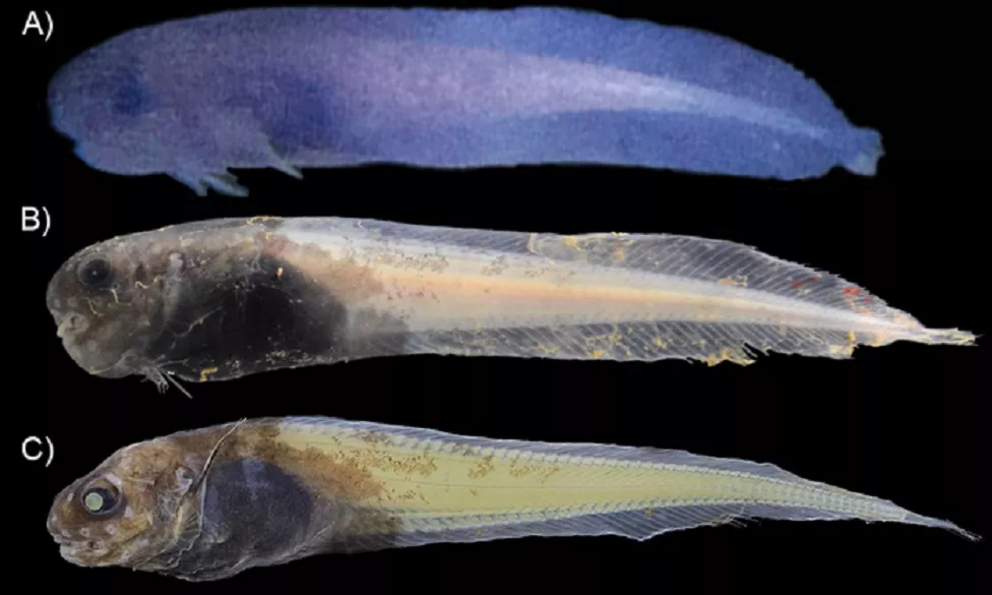Newly discovered blue snailfish found in the deep sea
'These aren't pointy-toothed monsters; they're pretty cute.'
Fact checked by Haley Mast
Blue and just a few inches long, a newly uncovered snailfish is helping researchers understand life in the deepest waters.
Scientists were recently exploring the Atacama Trench, a deep underwater valley in the eastern Pacific Ocean off the coast of Peru and Chile.1 They spotted three different hadal snailfish. Also called sea snails, snailfish have large heads, small eyes, and bodies that resemble tadpoles. “Hadal” means they are found in great ocean depths, below approximately 20,000 feet.2
One of the snailfish didn’t look like others that live in deep waters. Spotted at about 6,000 to 7,000 meters (20-23,000 feet) deep, it had large eyes and a bright blue color. It resembled other snailfish that are found in shallower waters.34
“Our team had been to this region in the past and we got some footage of a snailfish then. We were excited to get the chance to go back when we were invited on this expedition,” study lead author Thom Linley, a visiting researcher at Newcastle University in the U.K., tells Treehugger.
“We knew there was one new fish we wanted to know more about; we weren’t expecting to find three and for one to change our thinking so much.”
The team members used DNA barcoding and 3D X-rays to see where the blue fish fit in the snailfish family tree.3
They were surprised to discover that the new species belonged to the genus Paraliparis, which are common in the Antarctic’s Southern Ocean and are rarely found deeper than 2,000 meters (6,500 feet). This was the first time a member of the genus has been found living in such deep seas.3
The findings were published in the journal Marine Biodiversity.
Challenging Perceptions
Researchers named the new species Paraliparis selti, which means blue in the Kunza language of the indigenous peoples of the Atacama Desert.4
In the past, they had seen one snailfish in the area before, known for big wing-like fins. There was a different species that was known only by a single specimen that was found, but was damaged.5
“But then on this trip there was this little blue fish. It didn’t look like the other deep-sea members of this family,” Linley says. “It was this beautiful blue colour. It looked more like the species you would find shallower, particularly in polar regions. A branch of this family’s tree we hadn’t seen this deep before.”
They used cameras and traps with bait to study the blue fish that have adapted to the extreme depths.4 Most of their adaptations are cellular to help them live surrounded by such high pressure.5
“Their bodies are very low density and supported by the water around them. Much of their body is a clear gel and they have reduced the number of bones and their bone density,” Linley says. “They are so perfectly adapted to life at high pressure that they cannot exist at atmospheric pressure. Any specimens we retrieve rapidly melt away and we must work quickly to preserve them. This is why we like to go to them and take video: that is the right context to view deep-sea fish.”
He says, however, that describing a new species requires having a physical specimen. They just retrieved one, and it is only 9 centimeters (3.5 inches) long.5
“Describing a new species is always a great honour. It’s a part of science that stands the test of time. In hundreds of years’ time, even if the name has been changed, this animal will always carry our names with it,” Linley says.
“This little blue fish has no idea that it has changed how we think about the deep-sea snailfish. I’m particularly fond of the hadal snailfish. Not only are they living and thriving in a place that few other fish can even visit, they’re challenging our perceptions of deep-sea fishes. These aren’t pointy-toothed monsters; they’re pretty cute.”
For full references please use source link below.

